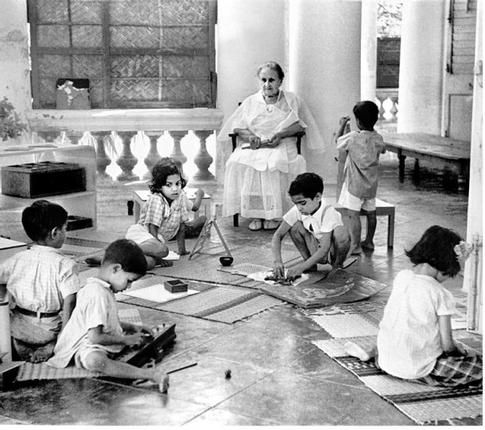|
متوسطه دوم و درس های ناگفته!
|
||
|
فقط از فهمیدن توست که می ترسند |
The Montessori Method of Education, developed by Italian physician Maria Montessori, is a child-centered educational approach based on scientific observations of children. Montessori's method has been used for over 100 years in many parts of the world.F
The Montessori method views the child as the one who is naturally eager for knowledge and capable of initiating learning in a supportive, thoughtfully prepared learning environment. It attempts to develop children physically, socially, emotionally and cognitively.F
Although a range of practices exist under the name "Montessori", the Association Montessori Internationale (AMI) and the American Montessori Society (AMS) cite these elements as essential: F
Mixed-age classrooms: classrooms for children ages 2 1⁄2 or 3 to 6 years old are by far the most common, but 0–3, 6–9, 9–12, 12–15, and 15–18-year-old classrooms exist as well
Student choice of activity from within a prescribed range of options
Uninterrupted blocks of work time, ideally three hours
A constructivist or "discovery" model, where students learn concepts from working with materials rather than by direct instruction
Specialized educational materials developed by Montessori and her collaborators often made out of natural, aesthetic materials such as wood rather than plastic
A thoughtfully prepared environment where materials are organized by subject area, within reach of the child, and are appropriate in size
Freedom within limits
A trained Montessori teacher who follows the child and is highly experienced in observing the individual child's characteristics, tendencies, innate talents, and abilities

Montessori education is fundamentally a model of human development and an educational approach based on that model. The model has two basic principles. First, children and developing adults engage in psychological self-construction by means of interaction with their environments. Second, children, especially under the age of six, have an innate path of psychological development. Based on her observations, Montessori believed that children who are at liberty to choose and act freely within an environment prepared according to her model would act spontaneously for optimal development.F
Montessori saw universal, innate characteristics in human psychology which her son and collaborator Mario Montessori identified as "human tendencies" in 1957. There is some debate about the exact list, but the following are clearly identified:F
Abstraction
Activity
Communication
Exactness
Exploration
(Manipulation (of the environment
Order
Orientation
Repetition
Self-Perfection
("Work (also described as "purposeful activity
In the Montessori approach, these human tendencies are seen as driving behaviour in every stage of development, and education should respond to and facilitate their expression.F
Montessori education involves free activity within a "prepared environment", meaning an educational environment tailored to basic human characteristics, to the specific characteristics of children at different ages, and to the individual personalities of each child. The function of the environment is to help and allow the child to develop independence in all areas according to his or her inner psychological directives. In addition to offering access to the Montessori materials appropriate to the age of the children, the environment should exhibit the following characteristics:F
An arrangement that facilitates movement and activity
Beauty and harmony, cleanliness of environment
Construction in proportion to the child and her/his needs
Limitation of materials, so that only material that supports the child's development is included
Order
Nature in the classroom and outside of the classroom
برچسبها: ماریا مونتسوری, آموزش و پرورش, معلمان جهان, ویکی پدیا

ماریا مونته سوری (1952 - 1870 میلادی) نخستین دختری بود که در ایتالیا
پزشک شد و سرپرستی یکی از مراکز کودکان معلول و بیمار را پذیرفت او در
آموزش و پرورش کودکان استثنایی و معلول روش نویی را به کار بست و به
جای برنامه های آموزشی موجود الگوی جدیدی برای بچه ها ارائه داد. مونته
سوری مراکزی را به نام «خانه ی کودکان» ایجاد کرد و محیطی مناسب و
مجانی برای کودکان به وجود آورد. در این مکان ها به آموزش و پرورش، رشد
اخلاقی و فیزیکی، و بهداشت کودکان توجه می شد.
طبق نظریه ی مونته سوری نیازهای کودکان در سه دوره ی اساسی و
اولیه ی رشد عبارتند از:
دوره ی آموزش حرکتی یا تجارب عملی زندگی؛
دوره ی آموزش حسی یا تربیت حواس و
دوره ی آموزش مهارت های خواندن و نوشتن.
برچسبها: تعلیم و تربیت, معلمان جهان, ماریا مونته سوری, خانه های کودک
اگر بـیـست عیـب در خود سـراغ داری،
برای بـرطـرف کردن ده تـای آن اقـدام کن
و سپـس آن ده تـای دیـگـر را هـدف قـرار
بده.
آنتون ماکارنکو
Anton Makarenko

برچسبها: آنتون ماکارنکو, معلمان جهان
|
|
